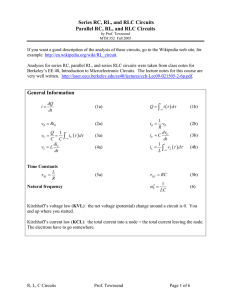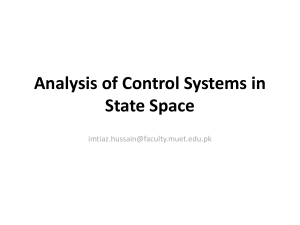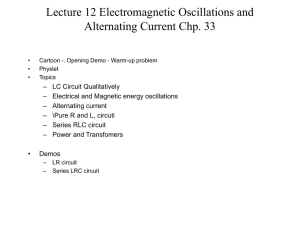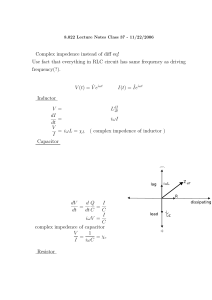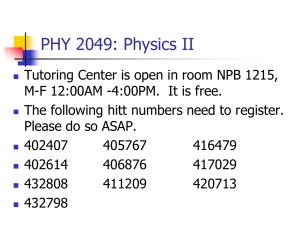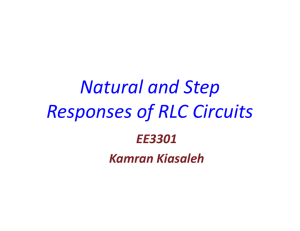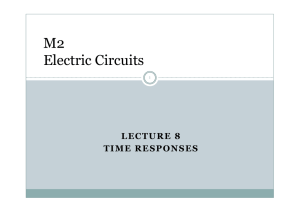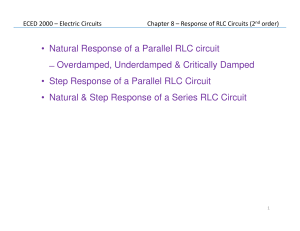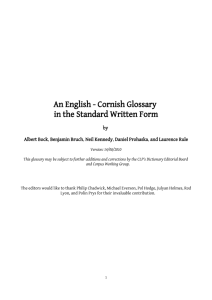ECE 2100 Circuit Analysis Lesson 37 Chapter 8: Second Order Circuits
advertisement
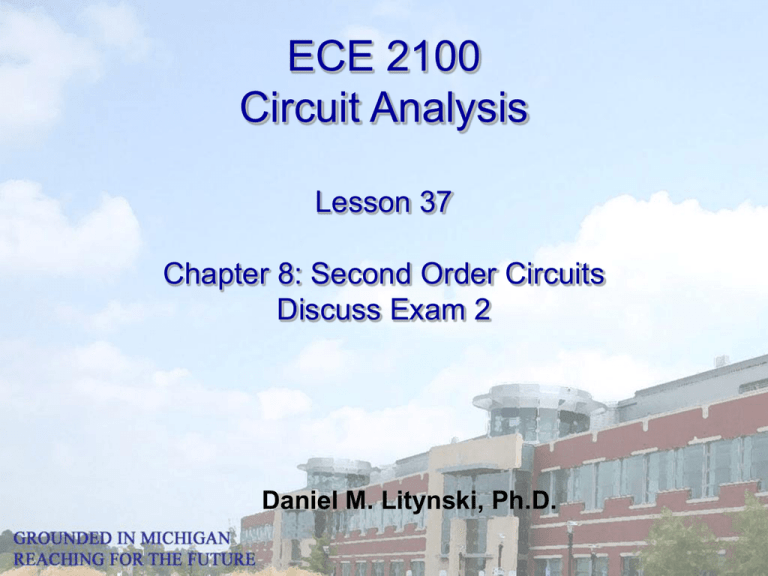
ECE 2100
Circuit Analysis
Lesson 37
Chapter 8: Second Order Circuits
Discuss Exam 2
Daniel M. Litynski, Ph.D.
Exam 2
•
•
•
•
•
•
•
CH
CH
CH
CH
CH
CH
CH
1-4: On Exam 1; Basis for work
5: Operational Amplifiers
6: Capacitors and Inductor
7-8: Later
9: Sinusoids and Phasors
10: Sinusoidal Steady State
11: AC Power Analysis
2
Practice Exam Topics
•
•
•
•
•
•
Sinusoid and Phasor Basics
Impedance concept
Operational Amplifiers
RLC AC circuit concepts
AC power transfer and load matching
Circuit Theorems in AC circuit analysis
3
Exam Prep
•
•
•
•
Text - Chapter summaries
Text – Chapter review questions
HW – Topics covered
Class Notes – comments and
examples
4
Exam Format
(Tentative)
•
•
•
•
•
Approx 5 problems
One short answers
OpAmp
AC Circuit Analysis
AC power
5
ECE 2100
Circuit Analysis
Chapter 8
Second-Order Circuits
Copyright © The McGraw-Hill Companies, Inc. Permission required for reproduction or display.
6
8.1 Examples of Second
Order RLC circuits (1)
What is a 2nd order circuit?
A second-order circuit is characterized by a secondorder differential equation. It consists of resistors
and the equivalent of two energy storage elements.
RLC Series
RLC Parallel
RL T-config
RC Pi-config
7
8.2 Finding Initial
and Final Values
Finding Initial
and Final Values of
v(0), i(0), dv(0)/dt,
di(0)/dt, v(∞), i(∞)
8
8.2 Finding Initial
and Final Values
Key Points for Finding Initial and Final Values:
1. Polarity of v(t) and i(t) using passive sign
convention (see Figs. 6.3 & 6.23)
2. Capacitor voltage is always continuous so
v(0+) = v(0-) for switch at t = 0
3. Inductor current is always continuous so
i(0+) = i(0-) for switch at t = 0
9
8.2 Finding Initial
and Final Values
Example 8.1: The switch in Fig. 8.2 has been
closed for a long time. It is opened at t = 0.
Find: (a) v(0+), i(0+), (b) dv(0+)/dt,
di(0+)/dt, (c) v(∞), i(∞)
10
8.2 Finding Initial
and Final Values
Example 8.2: In the circuit of Fig. 8.5,
calculate: (a) iL(0+), vC(0+), vR(0+), (b)
diL(0+)/dt, dvC(0+)/dt, dvR(0+)/dt, (c) iL(∞),
vC(∞), vR(∞)
11
8.3 Source-Free Series
RLC Circuits (1)
• The solution of the source-free
series RLC circuit is called as the
natural response of the circuit.
• The circuit is excited by the energy
initially stored in the capacitor and
inductor.
The 2nd
order of
expression
d 2i
dt 2
R di
L dt
i
0
LC
How to derive and how to solve?
12
8.3 Source-Free Series
RLC Circuits (2)
Method is illustrated
on pp. 320-324 of
textbook (review)
13
8.3 Source-Free Series
RLC Circuits (3)
There are three possible solutions for the following
2nd order differential equation:
d 2i
dt 2
=>
d 2i
di
2
dt 2
dt
2
0
R di
L dt
i 0
i
0
LC
where
R
2L
and
0
1
LC
General 2nd order Form
The types of solutions for i(t) depend
on the relative values of
and
14
8.3 Source-Free Series
RLC Circuits (4)
There are three possible solutions for the following
2nd order differential equation:
d 2i
di
2
dt 2
dt
1. If
>
o,
i(t ) A1e s1t
2. If
=
i(t ) ( A2
3. If
i(t ) e
<
t
o,
2
0
over-damped case
A2e s2t
( B1 cos
2
2
where s1, 2
0
critical damped case
A1t )e
o,
i 0
t
where
s1, 2
under-damped case
d
t B2 sin
d
t ) where
d
2
0
2
15
8.3 Source-Free Series
RLC Circuits (5)
Example 1
If R = 10 Ω, L = 5 H, and
C = 2 mF in Fig. 8.8, find
α, ω0, s1 and s2.
What type of natural
response will the circuit
have?
•
Practice Problem 8.3
16
8.3 Source-Free Series
RLC Circuits (6)
Example 2
The circuit shown below
has reached steady state
at t = 0-.
If the make-before-break
switch moves to position b
at t = 0, calculate i(t) for
t > 0.
• Practice Problem 8.4. Please refer to lecture or textbook for more
detailed elaboration.
Answer: i(t) = e–2.5t[5cos1.6583t – 7.538sin1.6583t] A
17
8.4 Source-Free Parallel
RLC Circuits (1)
0
Let
i (0) I 0
1
v(t )dt
L
v(0) = V0
Apply KCL to the top node:
t
v 1
dv
vdt C
0
R L
dt
Taking the derivative with
respect to t and dividing by C
The 2nd
order of
expression
d 2v
dt 2
1 dv
RC dt
1
v 0
LC
18
8.4 Source-Free Parallel
RLC Circuits (2)
There are three possible solutions for the following
2nd order differential equation:
d 2v
dt 2
1. If
v(t )
dv
dt
2
>
o,
A1 e s1t
2. If
=
v(t )
( A2
3. If
<
v(t ) e
2
0
t
o,
v
1
2 RC
where
and
1
LC
0
over-damped case
A2 e s2t where
2
2
s1, 2
0
critical damped case
A1t ) e
o,
0
where
t
s1, 2
under-damped case
( B1 cos
d
t
B2 sin
d
t ) where
d
2
0
2
19
8.4 Source-Free Parallel
RLC Circuits (3)
Example 3
Refer to the circuit shown below.
Find v(t) for t > 0.
• Practice Problem 8.6 modified. Please refer to lecture or textbook for
more detailed elaboration.
Answer:
v(t) = 66.67(e–10t – e–2.5t) V
20
8.5 Step-Response Series
RLC Circuits (1)
• The step response
is obtained by the
sudden application
of a dc source.
The 2nd
order of
expression
d 2v
2
dt
R dv
L dt
v
LC
vs
LC
The above equation has the same form as the equation for
source-free series RLC circuit.
• The same coefficients (important in determining the
frequency parameters).
• Different circuit variable in the equation.
21
8.5 Step-Response Series
RLC Circuits (2)
The solution of the equation should have two components:
the transient response vt(t) & the steady-state response vss(t):
v(t )
vt (t )
v ss (t )
The transient response vt is the same as that for source-free case
vt (t ) A1e s1t
A2e s2t
vt (t ) ( A1 A2t )e
vt (t ) e
t
(over-damped)
t
( A1 cos
(critically damped)
d
t
A2 sin
d
t ) (under-damped)
The steady-state response is the final value of v(t).
vss(t) = v(∞)
The values of A1 and A2 are obtained from the initial conditions:
v(0) and dv(0)/dt.
22
8.5 Step-Response Series
RLC Circuits (3)
Example 4
Having been in position for a long time, the
switch in the circuit below is moved to position b
at t = 0. Find v(t) and vR(t) for t > 0.
•
Practice Problem 8.7. Please refer to lecture or textbook for more detailed
elaboration.
Answer: v(t) = {10 + [(–2cos3.464t – 1.1547sin3.464t)e–2t]} V
vR(t)=
[2.31sin3.464t]e–2t
V
23
8.6 Step-Response Parallel
RLC Circuits (1)
• The step response
is obtained by the
sudden application
of a dc source.
The 2nd
order of
expression
d 2i
dt 2
1 di
RC dt
i
LC
Is
LC
It has the same form as the equation for source-free parallel
RLC circuit.
• The same coefficients (important in determining the
frequency parameters).
• Different circuit variable in the equation.
24
8.6 Step-Response Parallel
RLC Circuits (2)
The solution of the equation should have two components:
the transient response vt(t) & the steady-state response vss(t):
i(t ) it (t ) iss (t )
The transient response it is the same as that for source-free case
it (t ) A1e s1t
A2e s2t
it (t ) ( A1 A2t )e
it (t ) e
t
( A1 cos
(over-damped)
t
(critical damped)
d
t
A2 sin
d
t)
(under-damped)
The steady-state response is the final value of i(t).
iss(t) = i(∞) = Is
The values of A1 and A2 are obtained from the initial conditions:
i(0) and di(0)/dt.
25
8.6 Step-Response Parallel
RLC Circuits (3)
Example 5
Find i(t) and v(t) for t > 0 in the circuit shown
below:
• Practice Problem 8.8 modified. Please refer to lecture or textbook for
more detail elaboration.
Answer:
v(t) = Ldi/dt = 5x20sint = 100sint V
26
